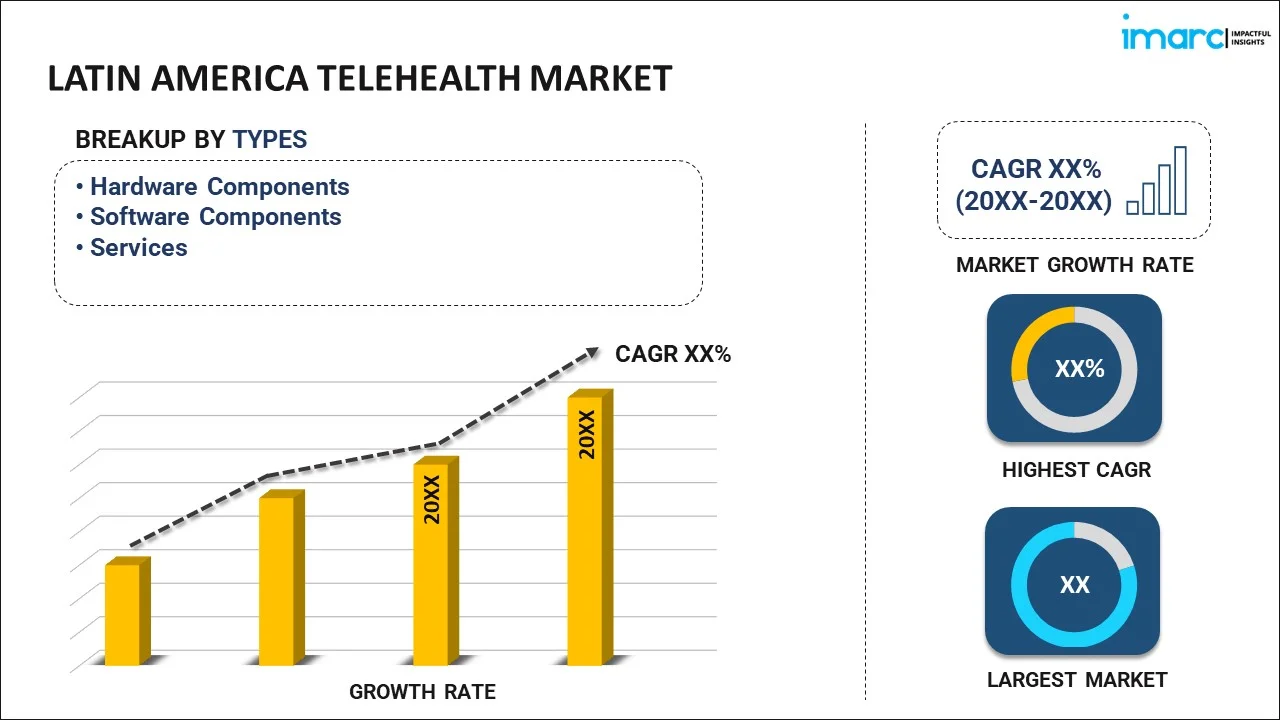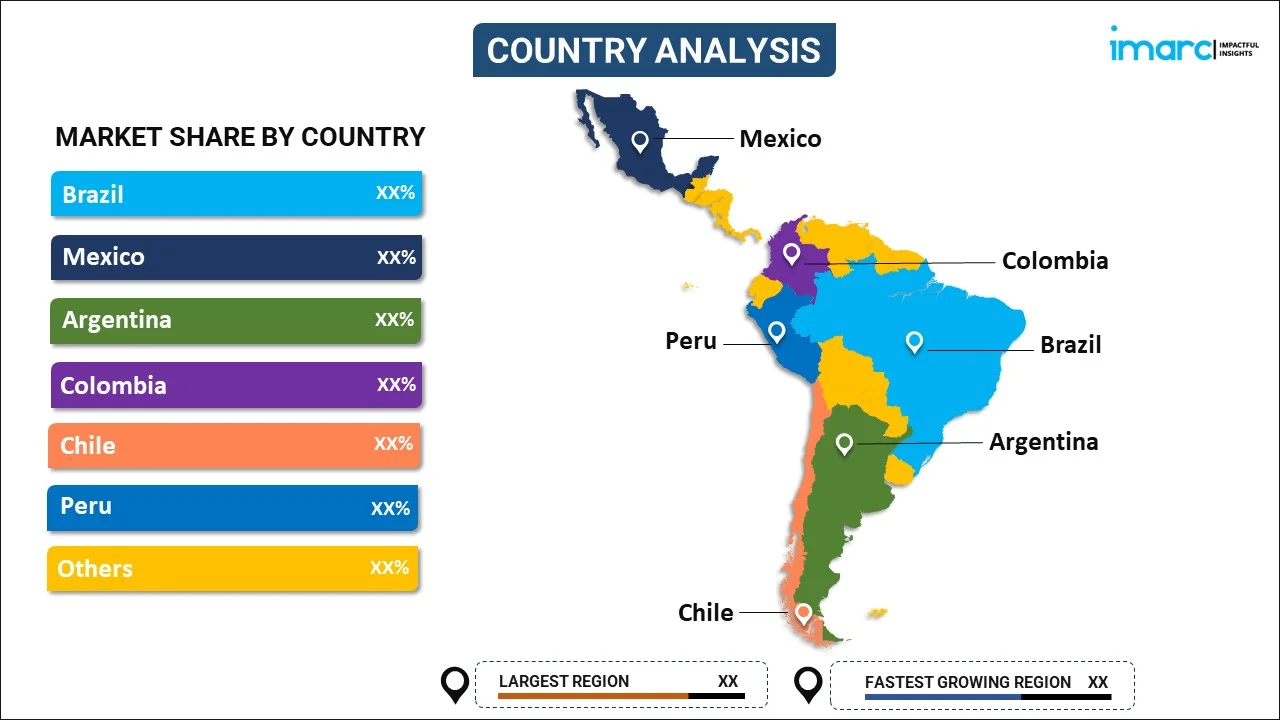
Latin America Telehealth Market Report by Type (Hardware Components, Software Components, Services), Communication Technology (Video Conferencing, mHealth Solutions, and Others), Hosting Type (Cloud-Based and Web-based, On-Premises), Application (Teleconsultation and Tele-mentoring, Medical Education and Training, Teleradiology, Telecardiology, Tele-ICU, Tele-Psychiatry, Tele-Dermatology, and Others), End User (Providers, Patients, Payers, and Others), and Country 2025-2033
Market Overview:
The Latin America telehealth market size reached USD 1.4 Billion in 2024. Looking forward, IMARC Group expects the market to reach USD 4.7 Billion by 2033, exhibiting a growth rate (CAGR) of 14.7% during 2025-2033.
|
Report Attribute
|
Key Statistics
|
|---|---|
|
Base Year
|
2024
|
|
Forecast Years
|
2025-2033
|
|
Historical Years
|
2019-2024
|
| Market Size in 2024 | USD 1.4 Billion |
| Market Forecast in 2033 | USD 4.7 Billion |
| Market Growth Rate 2025-2033 | 14.7% |
Telehealth refers to the remotely delivered medical services that are provided by the healthcare professionals to their patients using information and communication technologies. It is widely adopted by healthcare professionals for providing consultation, care management, patient monitoring, administrative meetings, imparting medical education, etc. Telehealth services are generally offered via video conferencing, electronic transmission of data, mobile health (mHealth) applications, remote patient monitoring (RPM), etc. These services are extensively used across numerous medical specialties, including radiology, cardiology, neurology, psychiatry, dermatology, etc.
In Latin America, the high prevalence of various chronic ailments, such as cardiovascular diseases, arthritis, cancer, etc., that require continual medical supervision is catalyzing the demand for telehealth services. Additionally, the growing geriatric population, who are more prone to serious medical conditions, is also driving the need for homecare-based medical treatment, thereby propelling the market in the region. Apart from this, the increasing penetration of digitalization trends in the healthcare sector is further augmenting the market growth. Moreover, the emergence of smart wearable devices has enabled healthcare professionals to track real-time patient statistics and provide accurate telehealth services. Additionally, with the sudden outbreak of the COVID-19 pandemic, several healthcare professionals, as well as patients, are opting for telehealth services to mitigate the risk of coronavirus infection upon the hospital or clinic visits. Besides this, the government bodies across Latin America are introducing various health initiatives for promoting the adoption of telehealth solutions which are also catalyzing the market growth in the region. Moreover, the rising integration of telehealth services with several innovative technologies, such as AI, predictive analytics, picture archiving and communication system (PACS), etc., will continue to drive the market in Latin America during the forecast period.
Key Market Segmentation:
IMARC Group provides an analysis of the key trends in each sub-segment of the Latin America telehealth market report, along with forecasts at the regional and country level from 2025-2033. Our report has categorized the market based on type, communication technology, hosting type, application and end user.
Breakup by Type:

- Hardware Components
- Software Components
- Services
Breakup by Communication Technology:
- Video Conferencing
- mHealth Solutions
- Others
Breakup by Hosting Type:
- Cloud-Based and Web-based
- On-Premises
Breakup by Application:
- Teleconsultation and Tele-mentoring
- Medical Education and Training
- Teleradiology
- Telecardiology
- Tele-ICU
- Tele-Psychiatry
- Tele-Dermatology
- Others
Breakup by End User:
- Providers
- Patients
- Payers
- Others
Breakup by Country:

- Brazil
- Mexico
- Argentina
- Colombia
- Chile
- Peru
- Others
Competitive Landscape:
The competitive landscape of the industry has also been examined with some of the key players being Aerotel Medical Systems, Boston Scientific Corporation, Cerner Corporation, Cisco Systems Inc., GE Healthcare (General Electric Company), GlobalMed (Schauenburg International GmbH), Honeywell International Inc., Medtronic, Philips Healthcare (Philips) and Siemens Healthineers (Siemens).
Report Coverage:
| Report Features | Details |
|---|---|
| Base Year of the Analysis | 2024 |
| Historical Period | 2019-2024 |
| Forecast Period | 2025-2033 |
| Units | Billion USD |
| Segment Coverage | Type, Communication Technology, Hosting Type, Application, End User, Country |
| Countries Covered | Brazil, Mexico, Argentina, Colombia, Chile, Peru, Others |
| Companies Covered | Aerotel Medical Systems, Boston Scientific Corporation, Cerner Corporation, Cisco Systems Inc., GE Healthcare (General Electric Company), GlobalMed (Schauenburg International GmbH), Honeywell International Inc., Medtronic, Philips Healthcare (Philips) and Siemens Healthineers (Siemens) |
| Customization Scope | 10% Free Customization |
| Post-Sale Analyst Support | 10-12 Weeks |
| Delivery Format | PDF and Excel through Email (We can also provide the editable version of the report in PPT/Word format on special request) |
Key Questions Answered in This Report
We expect the Latin America telehealth market to exhibit a CAGR of 14.7% during 2025-2033.
The rising prevalence of numerous lifestyle diseases, along with the increasing demand for wearable devices, such as smartwatches and bands, to keep a regular check on blood glucose levels, sleep patterns, chronic pain in the body, etc., is primarily driving the Latin America telehealth market.
The sudden outbreak of the COVID-19 pandemic has led to the growing adoption of telehealth services, such as Remote Patient Monitoring (RPM) and video conferencing, to reduce the risk of the coronavirus infection upon hospital visits and interaction with healthcare professionals across several Latin American nations.
Based on the type, the Latin America telehealth market can be segmented into hardware components, software components, and services. Currently, services hold the majority of the total market share.
Based on the hosting type, the Latin America telehealth market has been divided into cloud-based and web-based and on-premises, where cloud-based and web-based currently exhibits a clear dominance in the market.
Based on the end user, the Latin America telehealth market can be categorized into providers, patients, payers, and others. Among these, providers account for the largest market share.
On a regional level, the market has been classified into Brazil, Mexico, Argentina, Colombia, Chile, Peru, and others, where Brazil currently dominates the Latin America telehealth market.
Some of the major players in the Latin America telehealth market include Aerotel Medical Systems, Boston Scientific Corporation, Cerner Corporation, Cisco Systems Inc., GE Healthcare (General Electric Company), GlobalMed (Schauenburg International GmbH), Honeywell International Inc., Medtronic, Philips Healthcare (Philips), and Siemens Healthineers (Siemens).
Need more help?
- Speak to our experienced analysts for insights on the current market scenarios.
- Include additional segments and countries to customize the report as per your requirement.
- Gain an unparalleled competitive advantage in your domain by understanding how to utilize the report and positively impacting your operations and revenue.
- For further assistance, please connect with our analysts.
 Inquire Before Buying
Inquire Before Buying
 Speak to an Analyst
Speak to an Analyst
 Request Brochure
Request Brochure
 Request Customization
Request Customization




.webp)




.webp)












